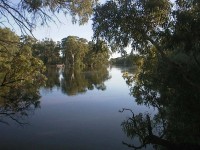By Stewart Franks, The Australian
Is the ongoing drought in the Murray-Darling Basin affected by climate change? The simple answer is that there is no evidence that CO2 has had any significant role. Like it or not, that is the science. In fact, the drought was caused by an entirely natural phenomenon: the 2002 El Nino event. This led to particularly low rainfalls across eastern Australia. The subsequent years were either neutral or weak El Nino conditions. Significantly, neutral conditions are not sufficient to break a drought. In 2006, we had a return to El Nino conditions which further exacerbated the drought. What we didn’t have was a strong La Nina.
Last year finally brought a La Nina event but it was relatively weak. It produced a number of major storm events in coastal areas and some useful rainfall in the Murray-Darling basin and elsewhere. Approximately half of NSW drought-declared areas were lifted out of drought (albeit into “marginal” status) and Sydney’s water supply doubled in the space of a few months.

This was the first rain-bearing La Nina since 1999 but proved insufficient to break the drought. In short, the drought was initiated by El Nino, protracted by further El Nino events and perhaps more importantly, the absence of substantial La Nina events. Despite the known causes of the drought, many have claimed that CO2 emissions are to blame. There have been arguments put forward to justify this claim, all eagerly adopted by various groups, but none of which have serious merit.
A key claim is that the multiple occurrence of El Nino is a sign of climate change. This is speculative at best. Recent analysis showed the nine-year absence of La Nina was not unusual. In fact long-term records demonstrate alternating periods of 20-40 years where El Nino is dominant, followed by similarly extended periods where La Nina dominates. Ominously, the data demonstrates that it is possible to go 14-15 years without any La Nina events. The consequent drought would be devastating but entirely natural.
The observation that El Nino and La Nina events cluster on 20-40 year, multi-decadal timescales is an important one. It demonstrates that Australia should always expect major changes in climate as a function of natural variability. When viewed in this light, the drought is most likely a recurring feature of the Australian climate. Read more here. Hear an interview that he did a month or two back with News Radio’s Kel Richards here.
Stewart Franks is a hydroclimatologist and an associate professor at the University of Newcastle School of Engineering. He is president-elect of the International Commission on the Coupled Land - Atmosphere System




